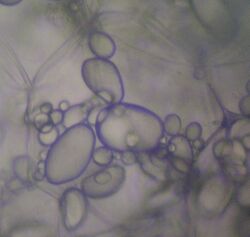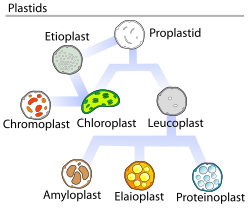Biology:Amyloplast

Amyloplasts are a type of plastid, double-enveloped organelles in plant cells that are involved in various biological pathways. Amyloplasts are specifically a type of leucoplast, a subcategory for colorless, non-pigment-containing plastids.[1][2] Amyloplasts are found in roots and storage tissues, and they store and synthesize starch for the plant through the polymerization of glucose.[1] Starch synthesis relies on the transportation of carbon from the cytosol, the mechanism by which is currently under debate.[2][3]
Starch synthesis and storage also takes place in chloroplasts, a type of pigmented plastid involved in photosynthesis.[1] Amyloplasts and chloroplasts are closely related, and amyloplasts can turn into chloroplasts; this is for instance observed when potato tubers are exposed to light and turn green.[4]
Role in gravity sensing

Amyloplasts are thought to play a vital role in gravitropism. Statoliths, a specialized starch-accumulating amyloplast, are denser than cytoplasm, and are able to settle to the bottom of the gravity-sensing cell, called a statocyte.[5] This settling is a vital mechanism in plant's perception of gravity, triggering the asymmetrical distribution of auxin that causes the curvature and growth of stems against the gravity vector, as well as growth of roots along the gravity vector.[6][7] A plant lacking in phosphoglucomutase (pgm), for example, is a starchless mutant plant, thus preventing the settling of the statoliths.[8] This mutant shows a significantly weaker gravitropic response as compared to a non-mutant plant.[8][9] A normal gravitropic response can be rescued with hypergravity.[9] In roots, gravity is sensed in the root cap, a section of tissue at the very tip of the root. Upon removal of the root cap, the root loses its ability to sense gravity.[5] However, if the root cap is regrown, the root's gravitropic response will recover.[10] In stems, gravity is sensed in the endodermal cells of the shoots.[5]
References
- ↑ 1.0 1.1 1.2 "The Diversity of Plastid Form and Function". The structure and function of plastids. 23. 2006-01-01. pp. 3–26. https://www.researchgate.net/publication/226671748. Retrieved 2018-11-28.
- ↑ 2.0 2.1 "Nonphotosynthetic Metabolism in Plastids". Annual Review of Plant Physiology and Plant Molecular Biology 51: 111–140. June 2000. doi:10.1146/annurev.arplant.51.1.111. PMID 15012188.
- ↑ "Starch synthesis in amyloplasts purified from developing potato tubers". The Plant Journal 11 (5): 1095–1103. March 2002. doi:10.1046/j.1365-313x.1997.11051095.x.
- ↑ "Development of chloroplasts from amyloplasts in potato tuber discs". New Phytologist 72 (3): 449–463. 1973. doi:10.1111/j.1469-8137.1973.tb04394.x.
- ↑ 5.0 5.1 5.2 "Directional gravity sensing in gravitropism". Annual Review of Plant Biology 61 (1): 705–20. 2010-06-02. doi:10.1146/annurev.arplant.043008.092042. PMID 19152486.
- ↑ "The endodermis and shoot gravitropism". Trends in Plant Science 4 (3): 103–7. March 1999. doi:10.1016/S1360-1385(99)01376-X. PMID 10322541.
- ↑ "Gravity sensing and signaling". Current Opinion in Plant Biology 7 (6): 712–8. December 2004. doi:10.1016/j.pbi.2004.09.001. PMID 15491921.
- ↑ 8.0 8.1 "Gravitropism in roots of intermediate-starch mutants of Arabidopsis". Physiologia Plantarum 97 (2): 237–44. June 1996. doi:10.1034/j.1399-3054.1996.970205.x. PMID 11539189.
- ↑ 9.0 9.1 "Amyloplast displacement is necessary for gravisensing in Arabidopsis shoots as revealed by a centrifuge microscope". The Plant Journal 76 (4): 648–60. November 2013. doi:10.1111/tpj.12324. PMID 24004104.
- ↑ "The role of the root cap in the response of the primary roots of Zea mays L. seedlings to white light and to gravity". Planta 123 (3): 217–22. January 1975. doi:10.1007/BF00390700. PMID 24435121.
 |
